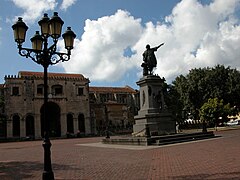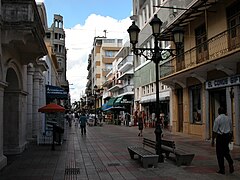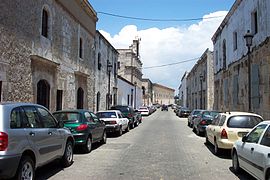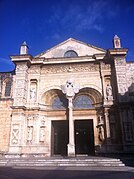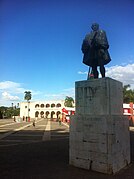Ciudad Colonial (Santo Domingo): Difference between revisions
→Colonial City today: touristic? |
|||
| Line 80: | Line 80: | ||
A 700 million US dollar investment was made in the Port of the Ozama river adjacent to the Ciudad Colonial aiming to turn Santo Domingo into a [[port of call]] for luxury cruise ships and including a privately owned marina. The project is being completed by Sans Soucí Ports S.A.<ref>http://www.seaportspr.com/viewir.cgi?newsletter_id=96&article_id=3219</ref> It is hoped that this ambitious project will boost the attraction of the Ciudad Colonial and the rest of Santo Domingo to international tourists. |
A 700 million US dollar investment was made in the Port of the Ozama river adjacent to the Ciudad Colonial aiming to turn Santo Domingo into a [[port of call]] for luxury cruise ships and including a privately owned marina. The project is being completed by Sans Soucí Ports S.A.<ref>http://www.seaportspr.com/viewir.cgi?newsletter_id=96&article_id=3219</ref> It is hoped that this ambitious project will boost the attraction of the Ciudad Colonial and the rest of Santo Domingo to international tourists. |
||
==Historical sites of Ciudad Colonial== |
|||
==Landmarks== |
|||
[[File:Zona colonial.jpg|thumb|190px|[[Calle El Conde]] in the Zona Colonial.]] |
[[File:Zona colonial.jpg|thumb|190px|[[Calle El Conde]] in the Zona Colonial.]] |
||
[[Image:Catedral Santo Domingo.jpg|thumb|190px|[[Catedral Santa María La Menor]], is the oldest cathedral built in the Americas]] |
[[Image:Catedral Santo Domingo.jpg|thumb|190px|[[Catedral Santa María La Menor]], is the oldest cathedral built in the Americas]] |
||
[[File:Ciudad Colonial IMG 0061.JPG|thumb|190px|Gate de la Misericordia in the Zona Colonial.]] |
|||
In the Ciudad Colonial there are different places built by the Spaniards during the colonial era, which together form more than 300 historical sites in the area; these include various monuments of cultural and historical character, as well as houses of great figures of the society of that time, but it can not fail to mention important streets, such as the Las Damas street. Some of these are: |
|||
{{Columns list| 3 | |
|||
The majority of the landmarks and cultural venues of the Zona Colonial were erected during the colonial period of Spanish rule. In spite of recent improvements, some are in desperate need of repairs and maintenance. |
|||
* Colonial Sewer |
|||
* [[Alcázar de Colón]] |
|||
===Churches and Religious Buildings=== |
|||
* Stronghold El Conde |
|||
* [[Catedral de Santa María la Menor]] |
|||
* Altar of the Nation |
|||
* Gate del Conde |
|||
* Park Independencia |
|||
* [[Calle El Conde]] |
|||
* [[Calle Las Damas]] |
|||
* [[Calle Las Mercedes]] |
|||
* Chapel of the Franciscan Third Order |
|||
* Chapel de los Remedios |
|||
* Chapel del Rosario |
|||
* Chapel de San Andrés |
|||
* Casa de Bastidas, once home to the prominent Bastidas family, now a children's museum (Museo Infantil) |
|||
* Casa de Diego Caballero |
|||
* Casa de "El Tapado" |
|||
* Casa de Hernán Cortés, French Embassy since 1999 and thought to be the former house of [[Hernán Cortés]] |
|||
* Casa de Juan de Viloria |
|||
* Casa de Juan Pablo Duarte |
|||
* Hostal of Nicolás de Ovando, in a 16th-century patrician house |
|||
* [[Casa del Tostado]], now the Museum of the Dominican Family (Museo de la Familia Dominicana), the only civilian building in the New World with a period [[Gothic art|gothic]] window |
|||
* Casa of the Dávila Family |
|||
* Casa of the Currency, with a door surrounded by five sculpted medallions in the early Renaissance style |
|||
* Casa of the Gargoyles |
|||
* Casa of the Jesuits |
|||
* [[Casa del Cordón]], perhaps the oldest still-erect stone building of the New World (1502) with a beautifully carved door frame in the form of a Franciscan monk's rope belt (''cordón'') |
|||
* Casa del Sacramento |
|||
* [[Basilica Cathedral of Santa María la Menor|First Cathedral of America]] |
|||
* Ceiba of Columbus |
|||
* [[Real and Pontifical University of Santiago de la Paz and Gorjón]] |
|||
* Convento Santa Clara |
|||
* Hermitage of San Antón |
|||
* Steps of Las Damas |
|||
* [[Fortress of Santo Domingo]] |
|||
* Fort of El Invencible |
|||
* Fort of La Carena |
|||
* Fort of La Caridad |
|||
* Fort of La Concepción |
|||
* Fort of San Diego |
|||
* Fort of San Gil |
|||
* Fort of San José |
|||
* Fort of El Angulo |
|||
* Church of San Miguel |
|||
* [[Church and Convent of the Dominican]] |
|||
* Church Hospital San Lázaro |
|||
* Church of Nuestra Señora de la Altagracia |
|||
* Church Las Mercedes |
|||
* Church Nuestra Señora del Carmen |
|||
* Church Regina Angelorum |
|||
* Church of Santa Bárbara |
|||
* Church of the Dominican Third Order |
|||
* Modelo Market |
|||
* [[Museo de las Casas Reales]] |
|||
* Museo de la Catedral |
* Museo de la Catedral |
||
* Ruins of the Franciscan Monastery (Monasterio de San Francisco) |
|||
* Church of the Dominicans |
|||
* Nuestra Señora de la Altagracia |
|||
* Church of Las Mercedes |
|||
* Ruins of Hospital San Nicolás de Bari, the New World's first hospital |
|||
* [[National Pantheon of the Dominican Republic|Panteón Nacional]], in a former [[Jesuit]] church |
|||
===Notable Houses and Museums=== |
|||
[[File:HOUSE OF THE CORD, SANTO DOMINGO, DOMINICAN REPUBLIC.jpg|thumb|upright=1|Casa del Cordon]] |
|||
* Casa del Tostado, now the Museum of the Dominican Family (Museo de la Familia Dominicana), the only civilian building in the New World with a period [[Gothic art|gothic]] window |
|||
* Casa de Bastidas, once home to the prominent Bastidas family, now a children's museum (Museo Infantil) |
|||
* Casa del Cordon, perhaps the oldest still-erect stone building of the New World (1502) with a beautifully carved door frame in the form of a Franciscan monk's rope belt (''cordon'') |
|||
* Casa de Francia, French Embassy since 1999 and thought to be the former house of [[Hernán Cortés]] |
|||
* Casa de la Moneda, with a door surrounded by five sculpted medallions in the early Renaissance style |
|||
* Hostal Nicolás de Ovando, in a 16th-century patrician house |
|||
* Museo de [[Juan Pablo Duarte]], in the house where the Dominican Republic's national hero was born |
* Museo de [[Juan Pablo Duarte]], in the house where the Dominican Republic's national hero was born |
||
* Museo Memorial de la Resistencia Dominicana, honoring the struggles against the [[Rafael Trujillo|Trujillo]] and [[Joaquín Balaguer|Balaguer]] regimes |
* Museo Memorial de la Resistencia Dominicana, honoring the struggles against the [[Rafael Trujillo|Trujillo]] and [[Joaquín Balaguer|Balaguer]] regimes |
||
* Telecommunications Museum |
|||
* Museo del Ambar |
* Museo del Ambar |
||
* Museo Larimar |
* Museo Larimar |
||
* Palace of the Captains |
|||
* Museo Naval de las Atarazanas |
|||
* [[Monasterio de San Francisco|Ruins of the Franciscan Monastery (Monasterio de San Francisco)]] |
|||
* Palace Consistoral |
|||
* Palace of Borgellá |
|||
* [[National Pantheon of the Dominican Republic|Panteón Nacional]], in a former [[Jesuit]] church |
|||
* Parque Colón (Columbus Park) |
|||
* Independence Park |
|||
* Plaza de España |
|||
* Plaza Fray Bartolomé de las Casas |
|||
* Plaza Duarte |
|||
* Plaza María de Toledo |
|||
* Plaza Montesinos |
|||
* Plaza Pellerano Castro |
|||
* Plazoleta de los Curas |
|||
* Plazoleta Padre Billini |
|||
* Gate de la Misericordia (see photo) |
|||
* Gate de las Reales Atarazanas |
|||
* Gates de San Diego |
|||
* Royal Shipyards (Reales Atarazanas) |
|||
* Sundial |
|||
* Remains of Ancient Walls |
|||
* Ruins of the Hospital San Nicolás de Bari, the New World's first hospital |
|||
* Ruins of San Francisco}} |
|||
==Gallery== |
==Gallery== |
||
Revision as of 23:43, 10 August 2015
Ciudad Colonial | |
|---|---|
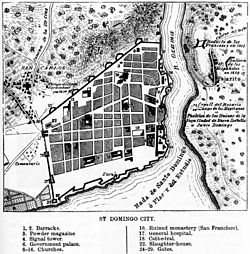 Map of Santo Domingo, 1873 | |
| Country | Dominican Republic |
| Province | Distrito Nacional |
| City | Santo Domingo |
| Time zone | UTC-4 UTC |
| • Summer (DST) | UTCNone |
| Type | Cultural |
| Criteria | ii, iv, vi |
| Designated | 1990 (21st session) |
| Reference no. | 526 |
| Region | Latin America and the Caribbean |
Ciudad Colonial (Spanish for "Colonial City") is the historic central neighborhood of Santo Domingo and the oldest permanent European settlement of the New World. It has been declared a World Heritage Site by UNESCO.[1] It is colloquially known as "Zona Colonial" (Colonial Zone). The Ciudad Colonial is located on the west bank of the Ozama River, which bisects the city. It covers less than 5 square kilometers.
It is an important section of the city due to the high number of landmarks, including Alcázar de Colón, Fortaleza Ozama, Catedral Primada de America, and others.
History
The first settlement of what is now Santo Domingo was established by Bartholomew Columbus on the East bank of the Ozama River. After the 1502 hurricane that claimed Francisco de Bobadilla among its victims, however, the city was relocated on the West bank under the leadership of Nicolás de Ovando. Ovando and his successor Diego Colón presided over the first constructions of the Colonial City, many of which still exist today. Santo Domingo's fortifications were an important feature of the urban landscape. The defense wall (murralla) extended from the Ozama River to the Puerta del Conde, which was the entrance to the hinterland and the Western boundary of the city until the late 19th century.
The Spaniards used this settlement as the first point of influence in the Americas, from which they conquered other Caribbean islands and much of the American mainland. Santo Domingo was initially the political and cultural hub of Spanish presence in the new world, but after a few decades started to decline as the Spaniards focused their attention more on the mainland after conquering Mexico, Peru, and other regions of Latin America. Ciudad Colonial nevertheless remained an important historical site.[2]

In 1655, the Ciudad Colonial was submitted to a siege led by the English officers William Penn and Robert Venables. The 1655 invasion was thwarted by Spanish troops commanded by the Captain General of the Colony, Don Bernardino de Meneses y Bracamonte, Count of Peñalva, to whom the Puerta del Conde ("Gate of the Count") is named after.[3] The defensive wall was modified during this episode. Prior to the invasion, there was a fort at the site where the Puerta del Conde is today, Fuerte San Genaro. It is believed that the modification that occurred after the siege involved the expansion of the wall to the fort, effectively creating a bastion, El Baluarte del Conde.
In the late 19th century and early 20th century, the city started to expand beyond its old boundaries but the Ciudad Colonial remained the main hub of activity until the Trujillo era. Trujillo also presided over the restoration of major monuments, including the Alcázar de Colón in the early 1950s.
Colonial City today
The Ciudad Colonial is now the main tourist attraction of Santo Domingo, even though the main sites of governmental and commercial activity are now in other parts of the city.
The central public space of the district is Parque Colon, a square that borders the 16th-century Cathedral and has a late-19th-century bronze statue of Christopher Columbus in its center. East of Parque Colón, the cobblestone Calle Las Damas is the New World's oldest paved street, dating from 1502. The street is bordered by many of the zone's more prominent landmarks, including Fortaleza Ozama, the site of major events in Dominican history; Casa de Bastidas, which now houses a children's museum; the French Embassy, in a building said to have been the house of Hernán Cortés; the Casa de Ovando, said to be the former residence of Governor Nicolás de Ovando and now a luxury hotel; the National Pantheon of the Dominican Republic; and the Museo de las Casas Reales, in the former governors' palace and Audiencia building.
Calle del Conde is a pedestrian-only street that includes several notable commercial buildings of the early 20th century and connects Parque Colon with the Puerta del Conde and Parque Independencia. Another traditional commercial district is the portion of Avenida Duarte just north of the Zona Colonial, which is currently undergoing a renovation plan that aims to make the area more appealing to tourists.[4]
On the north end of Calle Las Damas, the restored and expanded Plaza de España is bordered by Las Atarazanas (former naval yard, now a museum) and a number of small shops and restaurants. This area was one of the first commercial centers in the Americas, and is still a hub of activity today. The Alcázar de Colón, having once been the colonial palace of the Columbus family—beginning with his son Diego—is now a museum displaying period furniture and decorations. The building was originally built in 1510, and restored to its current appearance in 1952.
A 700 million US dollar investment was made in the Port of the Ozama river adjacent to the Ciudad Colonial aiming to turn Santo Domingo into a port of call for luxury cruise ships and including a privately owned marina. The project is being completed by Sans Soucí Ports S.A.[5] It is hoped that this ambitious project will boost the attraction of the Ciudad Colonial and the rest of Santo Domingo to international tourists.
Historical sites of Ciudad Colonial



In the Ciudad Colonial there are different places built by the Spaniards during the colonial era, which together form more than 300 historical sites in the area; these include various monuments of cultural and historical character, as well as houses of great figures of the society of that time, but it can not fail to mention important streets, such as the Las Damas street. Some of these are:
Gallery
-
Calle El Conde -
Calle Las Damas -
Plaza de España
References
- ^ UNESCO – Justification for Inscription
- ^ Santo Domingo; Fragmentos De Patria by Banreservas ISBN 99934-898-1-6
- ^ "El Baluarte del Conde". DiarioLibre.com. 2010. Retrieved 2010-07-28.
- ^ Inician asfaltado avenida DuarteDiario Libre Online - Spanish
- ^ http://www.seaportspr.com/viewir.cgi?newsletter_id=96&article_id=3219
